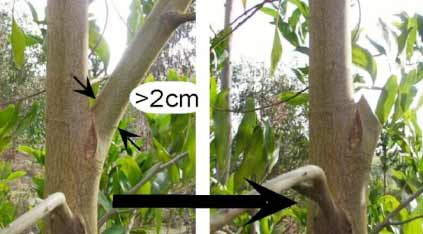|
|
|
Form and stability pruning

Early form-pruning corrects the shape of
young trees to encourage them to develop a single, straight
stem at least as high as the expected log length. Form-pruning
may not be required if there are sufficient vigorous, well-formed
trees, evenly spaced across the site. Instead, culling the
poor trees will immediately improve the form of a plantation.
However, where the selection ratio of suitable to non-suitable
trees is low, correcting tree form can enhance plantation
viability.
Form-pruning may be necessary within the first year if saplings
have developed more than one leading stem. This is common
when trees are grown from coppice or where young seedlings
are set back by frost or pest damage. The best single shoot
is identified, and the others cut back to the base.
Form-pruning may also be required in later years to correct
double leaders or to entice the main leader to grow straight
by removing large competitive branches. True double leaders
are evident from the slope of the bark ridge in the crouch
between the stems. If it is vertical, then one of the stems
must be removed leaving the straighter of the two. Form-pruning
of small (less than 2.5cm in diameter) branches is only required
if they are affecting the form of the leading stem.
The removal of large lateral branches earlier
than would be the case under a normal stem-pruning prescription
is a type of form pruning. This usually involves the removal
or shortening of large branches that may affect the form of
the main leader. This pre-emptive pruning can also reduce
the costs of later stem-pruning operations and help control
the size of the diameter over stubs (DOS) by removing branches
before they become very large. Where the risk of disease or
decay is of concern, pre-emptive pruning may also reduce the
risk of infection by reducing the size of the wounds. Annual
pre-emptive pruning of Acacia
melanoxylon, using a branch calliper
of about 2.5cm to identify any branch within the log length
that should be removed, has proven to be an effective means
of improving tree form and reducing stem-pruning costs.
A simple method of improving a very poorly
formed tree that has suffered from exposure or neglect is
coppicing. In species that coppice strongly, cutting them
back to ground level, usually in early autumn when the reserves
of carbohydrate are at their highest, can result in a strong
new shoot with much better form than the original tree.
Stability pruning
On exposed sites, particularly those prone
to waterlogging, young trees commonly suffer wind-throw or
toppling. Intensive soil cultivation (ripping and mounding)
and fertilisation at the time of tree establishment can induce
rapid leaf growth making the trees even more susceptible to
blowing over. Stability pruning involves the lightening of
the canopy of young trees in an attempt to reduce their sail
area and therefore the risk of toppling. Although it is possible
to correct a young wind-thrown tree, an early form-pruning
with an eye to tree stability may be warranted on susceptible
sites.
Back to top
 |
|
|
|
